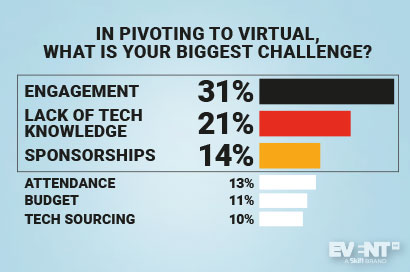Keeping Attendees Engaged Is the Biggest Challenge for Virtual Events

There has been a lot of hype around virtual events since the beginning of the pandemic, but not all of it has been borne out by experience. While some eventprofs have enjoyed higher profits and increased attendance rates as compared to live events, many are not finding the format to be a viable solution.
Online events present many challenges to planners, but some are more significant than others. Research published in The Virtual Event Tech Guide found that 21 percent of eventprofs consider lack of tech knowledge to be their biggest challenge when pivoting to virtual, while 31 percent — more than for any other challenge — cited engagement.
That said, virtual remains the safest option for business events, and this will likely be the case for quite some time. Both planners and providers will need to fully embrace virtual and find solutions together to be able to successfully meet the industry’s needs in the next few months.

The Engagement Puzzle
Despite the spike in demand for virtual over the last few months, the format is still unfamiliar to much of the industry that previously shunned it. Figuring out how to engage a remote audience is incredibly challenging and requires a different set of knowledge and skills than what most planners who are accustomed to live events may have been cultivating.
To make matters more difficult, virtual event tech is still lacking in many key areas, including engagement. Almost 50 percent of planners say that their biggest frustration when sourcing virtual event tech is its inability to match live engagement.
In terms of engagement features, most virtual event platforms are not particularly forward-thinking, relying mostly on existent staples like live polling and surveys. While useful, these tools alone are clearly not meeting planners’ and audiences’ needs.
A little over 8 percent of providers don’t even include any of these features, which is surprising considering that these are basic engagement tools that many eventprofs will likely be looking for as a minimum requirement for their virtual platforms.
In addition, 13 percent of planners noted that their biggest frustration was lack of support from tech providers. While this was the minority, it’s reasonable to assume that many other planners share this frustration despite it not being their main concern.
The fact that any amount of planners feels they’re not receiving adequate support is concerning, particularly considering that almost 60 percent of planners are not comfortable with the technology. Tech suppliers need to be more focused than ever on providing guidance on how to engage audiences to eventprofs planning virtual events if both parties are going to succeed in this newly-popular space.
How to Keep People Engaged Online
Keeping a virtual audience engaged is obviously easier said than done, but there are certain tips and best practices to keep in mind when designing engagement opportunities, even with the current tech available.
One of the most important things to focus on is making the experience interactive and allowing attendees to participate in the event. This can be achieved through the basic features mentioned above, but also through gamification elements or more innovative ideas like the empty chair panel we had in our recent Engage virtual event.
Another thing to keep in mind is the audience’s attention span — people can much more easily tune out, get distracted, or simply leave an online event (or be more willing to, especially if it’s free). In order to address this challenge, it’s important to limit session lengths and ensure the information is easily digestible. In addition, single-day events are generally the way to go with virtual.
Make sure the beginning of the event is exciting and energizes attendees so that they feel motivated to stay tuned. Remote audiences have become accustomed to polished content, and production value should not be underestimated. Many AV companies are also pivoting to support virtual events by providing sets, technical know-how and logistical support to ensure that events run smoothly and appear professional.
It’s also a good idea to provide attendees with some sort of onboarding to ensure that they understand how to work and explore the platform and can get the full value out of the event.
Finally, prioritize connections and networking opportunities between attendees. The fact that remote attendees can’t all be in a room together makes networking features and face-to-face connections all the more important. Whether it’s small breakout sessions or one-on-one networking video calls, plan for ways to allow attendees to make meaningful connections with each other.
IN CONCLUSION
We’ve only seen the beginnings of virtual events’ potential; planners will need to continue to explore this format until widespread live events resume — and likely even after. The offerings will inevitably improve to meet demand.
One of the biggest hurdles to overcome will be virtual engagement opportunities, which will determine whether many eventprofs come to consider virtual as a sustainable alternative to live events.




